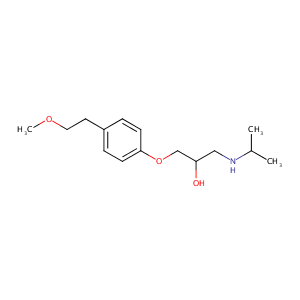Drug Information
| Drug General Information | Top | |||
|---|---|---|---|---|
| Drug ID |
D0I2MK
|
|||
| Former ID |
DAP000481
|
|||
| Drug Name |
Metoprolol
|
|||
| Synonyms |
Beatrolol; BelocDuriles; Betaloc; BetalocAstra; Betalok; Dutoprol; LOPRESSIDONE; Lopresor; Lopresoretic; Lopressor; Meijoprolol; Metohexal; Metoprololum; Metroprolol; Preblok; Presolol; Seloken; Seroken; Spesicor; Spesikor; Toprol; AstraZeneca Brand of Metaoprolol Tartrate; AstraZeneca Brand of Seloken; Beloc Duriles; Betaloc Astra; Leiras Brand of Metoprolol Succinate or Metoprolol Tartrate; Metoprolol succinate; Novartis Brand of Metprolol Tartrate; Seloken AstraZeneca Brand; CGP 2175; CGP2175; H 93 26; H 9326; Beloc-Duriles; Betaloc (TN); Betaloc-Astra; CGP-2175; Corvitol (TN); Dl-Metoprolol; H 93-26; Lopressor (TN); Metoprololum [INN-Latin]; Metrol (TN); Minax (TN); Neobloc (TN); Selo-Zok; Selokeen (TN); TOPROL-XL; Tartrate, Metoprolol; Metoprolol (USAN/INN); Metoprolol [USAN:INN:BAN]; Toprol-XL (TN); (RS)-Metoprolol; 1-(Isopropylamino)-3-(4-(2-methoxyethyl)phenoxy)propan-2-ol; 1-(Isopropylamino)-3-(p-(2-methoxyethyl)phenoxy)-2-propanol; 1-(isopropylamino)-3-[4-(2-methoxyethyl)phenoxy]propan-2-ol; 1-[(1-methylethyl)amino]-3-({4-[2-(methyloxy)ethyl]phenyl}oxy)propan-2-ol; 1-[4-(2-methoxyethyl)phenoxy]-3-(propan-2-ylamino)propan-2-ol; 1-[4-(2-methoxyethyl)phenoxy]-3-propan-2-ylamino-propan-2-ol; 3-[4-(2-methoxyethyl)phenoxy]-1-(propan-2-ylamino)propan-2-ol
Click to Show/Hide
|
|||
| Drug Type |
Small molecular drug
|
|||
| Indication | Hypertension [ICD-11: BA00-BA04] | Approved | [1], [2], [3] | |
| Therapeutic Class |
Antihypertensive Agents
|
|||
| Company |
AstraZeneca
|
|||
| Structure |
 |
Download2D MOL |
||
| Formula |
C15H25NO3
|
|||
| Canonical SMILES |
CC(C)NCC(COC1=CC=C(C=C1)CCOC)O
|
|||
| InChI |
1S/C15H25NO3/c1-12(2)16-10-14(17)11-19-15-6-4-13(5-7-15)8-9-18-3/h4-7,12,14,16-17H,8-11H2,1-3H3
|
|||
| InChIKey |
IUBSYMUCCVWXPE-UHFFFAOYSA-N
|
|||
| CAS Number |
CAS 51384-51-1
|
|||
| PubChem Compound ID | ||||
| PubChem Substance ID |
9411, 4904669, 7849417, 7979976, 8152611, 10520685, 11533336, 14799183, 29223277, 46506211, 48416268, 49698871, 50023420, 50103878, 50103879, 50103880, 53790219, 56310948, 56313025, 56413044, 57322176, 78524559, 81040953, 85209393, 85789202, 92309031, 92717148, 93619457, 99234266, 103164420, 104179199, 104305635, 117664446, 124749948, 124886734, 125349182, 126443769, 126524234, 126628938, 126639359, 126654065, 126670412, 126687042, 126732563, 128220647, 131312492, 131472906, 132210550, 134337774, 135144539
|
|||
| ChEBI ID |
CHEBI:6904
|
|||
| ADReCS Drug ID | BADD_D01445 ; BADD_D01446 ; BADD_D01447 | |||
| SuperDrug ATC ID |
C07AB02
|
|||
| SuperDrug CAS ID |
cas=037350586
|
|||
| Interaction between the Drug and Microbe | Top | |||
|---|---|---|---|---|
| The Metabolism of Drug Affected by Studied Microbe(s) | ||||
| The Order in the Taxonomic Hierarchy of the following Microbe(s): Bacteroidales | ||||
|
Studied Microbe: Bacteroides fragilis ATCC43859
Show/Hide Hierarchy
|
[4] | |||
| Hierarchy | ||||
| Experimental Method | High-throughput screening | |||
| Description | Metoprolol tartrate can be metabolized by Bacteroides fragilis ATCC43859 (log2FC = -0.328; p = 0.039). | |||
| The Order in the Taxonomic Hierarchy of the following Microbe(s): Bifidobacteriales | ||||
|
Studied Microbe: Bifidobacterium ruminantium
Show/Hide Hierarchy
|
[4] | |||
| Hierarchy | ||||
| Experimental Method | High-throughput screening | |||
| Description | Metoprolol tartrate can be metabolized by Bifidobacterium ruminantium (log2FC = -0.347; p = 0.023). | |||
| The Order in the Taxonomic Hierarchy of the following Microbe(s): Gut microbiota | ||||
| Studied Microbe: Gut microbiota unspecific | [5] | |||
| Description | Metoprolol can be metabolized by gut microbiota. | |||
| Target and Pathway | Top | |||
|---|---|---|---|---|
| Target(s) | Adrenergic receptor beta-1 (ADRB1) | Target Info | Antagonist | [6], [7], [8] |
| KEGG Pathway | Calcium signaling pathway | |||
| cGMP-PKG signaling pathway | ||||
| cAMP signaling pathway | ||||
| Neuroactive ligand-receptor interaction | ||||
| Endocytosis | ||||
| Adrenergic signaling in cardiomyocytes | ||||
| Gap junction | ||||
| Salivary secretion | ||||
| Dilated cardiomyopathy | ||||
| Panther Pathway | Heterotrimeric G-protein signaling pathway-Gi alpha and Gs alpha mediated pathway | |||
| Beta1 adrenergic receptor signaling pathway | ||||
| Pathwhiz Pathway | Muscle/Heart Contraction | |||
| Reactome | Adrenoceptors | |||
| G alpha (s) signalling events | ||||
| WikiPathways | Monoamine GPCRs | |||
| Calcium Regulation in the Cardiac Cell | ||||
| GPCRs, Class A Rhodopsin-like | ||||
| Endothelin Pathways | ||||
| GPCR ligand binding | ||||
| GPCR downstream signaling | ||||
| References | Top | |||
|---|---|---|---|---|
| REF 1 | URL: http://www.guidetopharmacology.org Nucleic Acids Res. 2015 Oct 12. pii: gkv1037. The IUPHAR/BPS Guide to PHARMACOLOGY in 2016: towards curated quantitative interactions between 1300 protein targets and 6000 ligands. (Ligand id: 553). | |||
| REF 2 | Metoprolol: a review of its use in chronic heart failure. Drugs. 2000 Sep;60(3):647-78. | |||
| REF 3 | The effect of food on the relative bioavailability of rapidly dissolving immediate-release solid oral products containing highly soluble drugs. Mol Pharm. 2004 Sep-Oct;1(5):357-62. | |||
| REF 4 | Mapping human microbiome drug metabolism by gut bacteria and their genes. Nature. 2019 Jun;570(7762):462-467. | |||
| REF 5 | Biodegradability of fluoxetine, mefenamic acid, and metoprolol using different microbial consortiums. Environ Sci Pollut Res Int. 2017 Mar;24(7):6779-6793. | |||
| REF 6 | Prediction and experimental validation of acute toxicity of beta-blockers in Ceriodaphnia dubia. Environ Toxicol Chem. 2005 Oct;24(10):2470-6. | |||
| REF 7 | Knockouts model the 100 best-selling drugs--will they model the next 100 Nat Rev Drug Discov. 2003 Jan;2(1):38-51. | |||
| REF 8 | Current therapeutic uses and potential of beta-adrenoceptor agonists and antagonists. Eur J Clin Pharmacol. 1998 Feb;53(6):389-404. | |||
If You Find Any Error in Data or Bug in Web Service, Please Kindly Report It to Dr. Zhou and Dr. Zhang.

